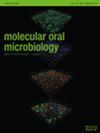一种新型甘露糖唾液蛋白粘附素参与白色念珠菌细胞与DMBT1的结合。
IF 2.8
3区 医学
Q1 DENTISTRY, ORAL SURGERY & MEDICINE
引用次数: 1
摘要
白色念珠菌定植于口腔,与致龋变形链球菌协同作用,引起口腔念珠菌病和儿童早期龋齿。口腔组织中白色念珠菌的定植是这些传染病发生的重要步骤。DMBT1(在恶性脑肿瘤中缺失1),也被称为唾液凝集素或gp-340,属于富含半胱氨酸(SRCR)的清道夫受体超家族,在先天免疫中具有重要功能。在口腔中,DMBT1导致微生物粘附在牙釉质和口腔黏膜表面,但白色念珠菌对DMBT1的粘附尚未被研究。在这项研究中,我们研究了白色念珠菌与DMBT1的结合,并分离了负责结合的真菌成分。白色念珠菌特异性地与DMBT1结合,并与肽结构域SRCRP2强烈结合。n -乙酰神经氨酸和甘露糖以及识别这些糖的凝集素抑制了与SRCRP2的结合。分离得到的组分分子量为25 kDa,含有唾液酸和甘露糖残基,可抑制白色念珠菌与SRCRP2的结合。免疫染色和细胞ELISA法证实了25-kDa蛋白在白色念珠菌细胞壁表面的定位,免疫印迹法证实了25-kDa蛋白在白色念珠菌细胞壁部分的存在。这些结果表明,分离的黏附素定位于白色念珠菌细胞壁表面,黏附素中的唾液酸和甘露糖残基在结合反应中起重要作用。这篇文章受版权保护。版权所有。本文章由计算机程序翻译,如有差异,请以英文原文为准。
A novel mannose-containing sialoprotein adhesin involved in the binding of Candida albicans cells to DMBT1.
Candida albicans colonizes the oral cavity and causes oral candidiasis and early childhood caries synergistically with cariogenic Streptococcus mutans. Colonization of oral tissues with C. albicans is an essential step in the initiation of these infectious diseases. DMBT1 (deleted in malignant brain tumors 1), also known as salivary agglutinin or gp-340, belongs to the scavenger receptor cysteine-rich (SRCR) superfamily and has important functions in innate immunity. In the oral cavity, DMBT1 causes microbial adherence to tooth enamel and oral mucosa surfaces, but the adherence of C. albicans to DMBT1 has not been examined. In this study, we investigated the binding of C. albicans to DMBT1 and isolated the fungal components responsible for the binding. C. albicans specifically bound to DMBT1 and strongly bound to the peptide domain SRCRP2. Binding to SRCRP2 was inhibited by N-acetylneuraminic acid and mannose and by lectins recognizing these sugars. The isolated component had a molecular mass of 25 kDa, contained sialic acid and mannose residues, and inhibited C. albicans binding to SRCRP2. The localization of the 25-kDa protein on the surface of C. albicans cell walls was confirmed by immunostaining and a cell ELISA using an antiserum to the protein, and Western blotting revealed the presence of the 25-kDa protein in the cell wall fraction of C. albicans. These results suggest that the isolated adhesin is localized on the surface of C. albicans cell walls and that sialic acid and mannose residues in the adhesin play a significant role in the binding reaction. This article is protected by copyright. All rights reserved.
求助全文
通过发布文献求助,成功后即可免费获取论文全文。
去求助
来源期刊

Molecular Oral Microbiology
DENTISTRY, ORAL SURGERY & MEDICINE-MICROBIOLOGY
CiteScore
6.50
自引率
5.40%
发文量
46
审稿时长
>12 weeks
期刊介绍:
Molecular Oral Microbiology publishes high quality research papers and reviews on fundamental or applied molecular studies of microorganisms of the oral cavity and respiratory tract, host-microbe interactions, cellular microbiology, molecular ecology, and immunological studies of oral and respiratory tract infections.
Papers describing work in virology, or in immunology unrelated to microbial colonization or infection, will not be acceptable. Studies of the prevalence of organisms or of antimicrobials agents also are not within the scope of the journal.
The journal does not publish Short Communications or Letters to the Editor.
Molecular Oral Microbiology is published bimonthly.
 求助内容:
求助内容: 应助结果提醒方式:
应助结果提醒方式:


